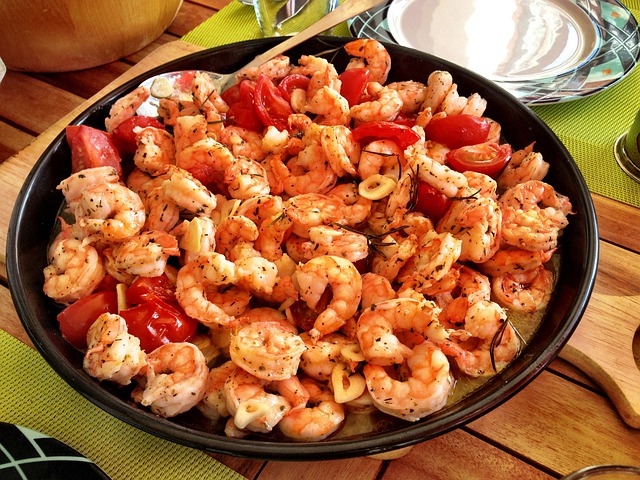
How to reheat shrimp? Easy Step-By-Step Guide
If you love shrimp, chances are you’ll enjoy it even more when it’s fresh. However, there may be occasions when you’re not able to cook shrimp up right away. Luckily, there are a number of ways to reheat shrimp without compromising its quality or taste. In this blog post, we’ll explore different methods for reheating shrimp so that you can choose the one that works best for you. By following these simple tips, you’ll be able to enjoy your favorite seafood dish any time of day!
When you’re looking for a quick, healthy meal, shrimp is often a good choice. However, if you don’t eat all of your shrimp in one sitting, you’ll need to know how to reheat shrimp properly. Here are a few tips for reheating shrimp safely and deliciously.
Table of Contents
About The Shrimp
Shrimp are small, marine crustaceans that are popular as a food source around the world. They vary in size and appearance, but all shrimp have protruding claws and a distinctive curved shape. Shrimp are low in calories and fat, and high in protein, making them a healthy choice for many people. There are many different ways to cook shrimp, including frying, boiling, grilling, and baking.
Shrimp are a versatile ingredient that can be used in a variety of dishes. They can be served as appetizers, main courses, or side dishes. Shrimp can also be used in salads, soups, and pasta dishes. When buying shrimp, it is important to choose fresh, high-quality shrimp. Shrimp should be firm to the touch and have a pinkish color. Avoid shrimp that are gray or translucent, as these are signs of spoilage. Fresh shrimp can be stored in the refrigerator for up to two days. If you are not going to use them within that time frame, they can be frozen for up to six months.
When cooking shrimp, it is important not to overcook them. Shrimp are best cooked just until they are opaque in the center. Overcooked shrimp will be tough and rubbery. To avoid this, cook shrimp on medium-high heat for two to three minutes per side, or until they are pink and slightly firm to the touch.
There are many different recipes that feature shrimp as the main ingredient. Whether you are looking for an easy weeknight meal or a more sophisticated dish for entertaining, there is a shrimp recipe out there for you. Try something new today and explore all the delicious possibilities that shrimp have to offer!
What Is The Nutritional Value Of Cooked Shrimp?
Shrimp is a popular seafood choice for many people, and it can be cooked in a variety of ways. Whether you’re grilling, frying, or boiling shrimp, you may be wondering about the nutritional value of cooked shrimp.
One 3-ounce serving of cooked shrimp contains approximately 84 calories, 1 gram of fat, 23 grams of protein, and 0 grams of carbohydrates. Shrimp is also a good source of omega-3 fatty acids, which are beneficial for heart health. Additionally, shrimp is low in mercury content compared to other fish, making it a safer seafood choice for pregnant women and young children.
When it comes to the nutritional value of cooked shrimp, there are many benefits to enjoy. This seafood option is low in calories and fat, and it’s a good source of protein and omega-3 fatty acids. Keep in mind, however, that the way you cook shrimp can affect its nutritional value. For example, shrimp that is fried in batter or oil will contain more fat and calories than shrimp that is grilled or boiled. If you’re watching your weight or trying to eat healthier, opt for healthier cooking methods such as grilling or boiling.
Can I Reheat My Shrimp?
If you’re wondering whether it’s safe to reheat shrimp, the answer is yes – as long as you follow a few simple guidelines. First of all, only reheat shrimp that has been cooked properly the first time around. overcooked shrimp can become tough and rubbery, so it’s best to avoid reheating it if possible. Secondly, make sure the shrimp is fully cooked before you attempt to reheat it. Undercooked shrimp can be dangerous to eat, so always err on the side of caution. Finally, be sure to reheat the shrimp evenly to avoid hot spots that could cause food poisoning.
With these simple tips in mind, you can safely and successfully reheat your shrimp dishes!
What Are Different Methods To Reheat Shrimp?
There are several methods that can be used to reheat shrimp. The most common methods include using the stove, oven, or microwave. Each method has its own set of benefits and drawbacks that should be considered before reheating shrimp.
The stove is the most common method used to reheat shrimp. This method is quick and easy, and it allows you to control the heat of the shrimp more easily than other methods. However, it is important to be careful not to overcook the shrimp, as this can cause them to become tough and dry.
The oven is another popular method for reheating shrimp. This method takes longer than using the stove, but it provides a more even heat that can help prevent the shrimp from drying out. However, it is important to keep an eye on the shrimp while they are reheating in the oven, as they can overcook quickly.
The microwave is the quickest way to reheat shrimp. This method is convenient and fast, but it can sometimes cause the shrimp to become rubbery. If you are using the microwave to reheat shrimp, be sure to use a low setting and check on them frequently to prevent overcooking.
No matter which method you choose to reheat shrimp, be sure to cooked them thoroughly before eating. This will help prevent food poisoning. Reheated shrimp can be stored in the fridge for up to three days.
How To Reheat Shrimp In Oven?
There are a few different ways that you can reheat shrimp in the oven, depending on what you are looking to achieve. If you want to keep the shrimp moist and juicy, then you will want to cook them at a lower temperature for a shorter amount of time. If you are looking to crisp up the shrimp, then you will want to cook them at a higher temperature for a longer amount of time.
– Preheat your oven to 375 degrees Fahrenheit.
– Line a baking sheet with foil or parchment paper.
– Spread the shrimp out in a single layer on the baking sheet.
– Bake for 5-7 minutes, or until cooked through.
– Remove from the oven and enjoy!
How To Reheat Shrimp On The Stove?
Learning how to reheat shrimp on the stove is a great way to enjoy your seafood without having to go through the hassle of cooking it from scratch. This method is quick and easy, and will allow you to enjoy your shrimp in just a few minutes.
– Begin by heating up a pan on the stove over medium heat.
– Add a bit of oil to the pan, enough to coat the bottom.
– Add your shrimp to the pan.
– Cook for a few minutes, flipping once, until the shrimp are cooked through.
– Remove from the heat and serve immediately. Enjoy!
How To Reheat Shrimp In Microwave?
If you’re looking for a quick and easy way to reheat shrimp, the microwave is the perfect solution! In just a few minutes, you can have perfectly cooked shrimp that’s ready to enjoy. Here’s a step-by-step guide on how to reheat shrimp in the microwave:
– Place the shrimp onto a microwavable safe plate or dish.
– Add a little bit of water or chicken broth onto the plate/dish, just enough to cover the bottom.
– Cover the plate/dish with a lid or plastic wrap. Make sure there are no holes or openings in the coverage.
– Cook on high power for 1-2 minutes, or until the shrimp are heated through. Enjoy!
Remember, it’s important not to overcook the shrimp or they will become rubbery. If you’re unsure if they’re done, err on the side of caution and check them after 1 minute of cooking. They should be pink and opaque when they’re finished. Once you’ve mastered how to reheat shrimp in the microwave, you’ll never go back to any other method!
What Are Some Tips To Reheat Shrimp?
There are a few things to keep in mind when reheating shrimp. First, shrimp should be cooked just until they are opaque in the center. Overcooked shrimp will become tough and rubbery. Second, reheat shrimp gently to preserve their moisture and flavor. Reheat in a covered dish on low heat or in a moist environment such as steaming. Finally, be sure to consume shrimp within two days of cooking for food safety.
When reheating cooked shrimp, it is important to cook them just until they are warmed through. Overcooking will cause the shrimp to become tough and rubbery. The best way to reheat shrimp is gently, using low heat or steam. This will help preserve their moisture and flavor. Be sure to consume shrimp within two days of cooking for food safety.
What Are The Most Common Mistakes People Make When To Reheat Shrimp?
When it comes to reheating shrimp, there are a few mistakes that people commonly make. Here are four of the most common mistakes to avoid when reheating shrimp:
– Not thawing shrimp before cooking: This is a mistake because shrimp should always be cooked from a completely thawed state for best results. If they are not thawed, they will not cook evenly and could end up rubbery.
– Overcooking shrimp: Another common mistake when reheating shrimp is to overcook them. This will cause them to become tough and chewy. It is best to reheat shrimp until they are just heated through and no longer pink in the center.
– Not using enough moisture: When reheating shrimp, it is important to use enough moisture so that they do not dry out. This can be accomplished by adding a little bit of water or broth to the pan when reheating.
– Not adding flavor: When shrimp are reheated, they can sometimes lose their flavor. To avoid this, it is important to add some seasonings or sauces to the shrimp before reheating. This will help them to retain their flavor and keep them moist.
– Not using the proper methods: There are several different methods that can be used to reheat shrimp. The best method will depend on the type of shrimp that you are reheating and the desired results. For example, if you want to preserve the moisture in the shrimp, steaming them would be a better option than frying them.
By following these tips, you can avoid making common mistakes when reheating shrimp. This will help you to ensure that they are cooked properly and retain their flavor.
Can I Reheat Shrimp More Than Once?
If you’re wondering if it’s safe to reheat shrimp, the answer is yes – but only under certain conditions. Shrimp is a delicate seafood that can easily become rubbery or dry if not cooked properly. That’s why it’s important to take care when reheating shrimp so that it retains its flavor and texture.
Here are some tips for how to reheat shrimp:
– Only reheat shrimp that has been cooked properly the first time around. Overcooked or undercooked shrimp will not taste as good when reheated.
– If possible, reheat shrimp in the same cooking method that was used originally. For example, if the shrimp was grilled, try reheating it on the grill again.
– Be careful not to overcook the shrimp when reheating. Reheating will cook the shrimp further, so only heat it for a short period of time.
– Add moisture to the shrimp when reheating so that it doesn’t become dry. This can be done by adding a bit of water or broth to the pan, or by covering the shrimp with a damp paper towel.
By following these tips, you can enjoy delicious, moist, and flavorful shrimp even if it’s been reheated!
FAQs About How To Reheat Shrimp
What Is The Best Way To Store Leftover Cooked Shrimp?
There are a few different ways that you can store cooked shrimp. The best way will depend on how long you need to store the shrimp, and your personal preferences.
If you only need to store the cooked shrimp for a short period of time, you can keep it in the refrigerator. Simply place the cooked shrimp in an airtight container and store it in the fridge for up to three days.
For longer-term storage, you can freeze the cooked shrimp. This will help to preserve the shrimp for up to six months. To freeze, simply place the cooked shrimp in an airtight freezer-safe container. When you’re ready to eat, thaw the shrimp in the fridge and enjoy!
No matter how you choose to store your cooked shrimp, be sure to consume it within a few days for the best quality.
How Can I Tell If Shrimp Have Gone Bad?
There are a few ways to tell if shrimp have gone bad. First, check the color. Fresh shrimp should be pink or grayish white. If they are any other color, they are probably not fresh. Second, check the texture. Shrimp should be firm and slightly springy to the touch. If they are mushy or slimy, they are no good. Finally, smell them. Shrimp should have a mild ocean smell. If they smell fishy or ammonia-like, throw them out.
If you’re not sure whether or not your shrimp are still good, it’s always better to err on the side of caution and throw them out. Eating bad shrimp can cause food poisoning, which can be very unpleasant. Symptoms of food poisoning include nausea, vomiting, and diarrhea. In severe cases, it can even lead to death. So it’s definitely not worth the risk!
Is It Safe To Eat Shrimp That Have Been Frozen?
Yes, it is safe to eat shrimp that have been frozen. Shrimp are a type of seafood that are highly perishable, so they are typically frozen soon after being caught. When properly stored, frozen shrimp can last for up to six months. When thawing frozen shrimp, it is important to do so safely in order to avoid bacteria growth. The best way to thaw shrimp is to place them in the refrigerator overnight. Once thawed, cooked shrimp should be eaten within two days.
How Long Does Cooked Shrimp Last In The Fridge?
Cooked shrimp can last in the fridge for 3-4 days or in the freezer for 2-6 months. Be sure to store cooked shrimp in an airtight container and keep it at 40 degrees Fahrenheit or below. If you’re unsure if your shrimp is still good, check for any signs of spoilage like a bad odor or discoloration.
When it comes to cooked shrimp, freshness is key. That’s why it’s important to know how to store cooked shrimp properly so it stays fresh and delicious. Here are some tips on how to keep your cooked shrimp tasting great:
– Store cooked shrimp in an airtight container. This will help keep the shrimp fresh and prevent it from drying out.
– Keep cooked shrimp refrigerated. Cooked shrimp should be kept at a temperature of 40 degrees Fahrenheit or below.
– Freeze cooked shrimp if you won’t be using it within a few days. Cooked shrimp can be stored in the freezer for up to 2-6 months. Just be sure to wrap it tightly in freezer-safe wrap or place it in a freezer-safe bag before freezing.
When storing cooked shrimp, it’s also important to avoid cross contamination by keeping it away from raw seafood, poultry, and meat. Be sure to wash your hands thoroughly after handling raw seafood before touching any other food. And always store cooked shrimp separate from other foods in your fridge or freezer.
Now that you know how to store cooked shrimp, it’s time to enjoy it! cooked shrimp is a great addition to many recipes like salads, pasta dishes, and stir-fries. Or you can simply enjoy it as a delicious appetizer with some cocktail sauce. No matter how you eat it, cooked shrimp is a healthy and delicious seafood option.
Can I Reheat Shrimp In The Microwave?
When it comes to seafood, there are a lot of different opinion on what can and cannot be reheated. Some people believe that all seafood is fair game when it comes to reheating, while others believe that only certain types of seafood can be reheated without sacrificing flavor or quality. So, where does shrimp fall on this spectrum? Can you reheat shrimp in the microwave?
The answer is yes, you can reheat shrimp in the microwave. However, it is important to keep a few things in mind if you do choose to reheat shrimp in the microwave. First of all, make sure that the shrimp is cooked all the way through before you attempt to reheat it. Shrimp should be opaque and pink in color when it is cooked all the way through. If your shrimp is not cooked all the way through, it is important to cook it thoroughly before reheating it in the microwave.
Another thing to keep in mind when reheating shrimp in the microwave is to make sure that you do not overcook the shrimp. This can cause the shrimp to become rubbery and tough. When reheating shrimp, only heat it for a minute or two until it is warmed all the way through.
If you follow these tips, you should be able to successfully reheat shrimp in the microwave without any problems.
What Is The Best Way To Cook Frozen Shrimp?
Frozen shrimp is a great seafood option for those looking for something quick and easy. While there are many ways to cook frozen shrimp, some methods are better than others. Here are a few tips on how to cook frozen shrimp:
– If possible, always thaw your shrimp before cooking. This will help ensure that they cook evenly and prevent them from drying out.
– When cooking frozen shrimp, be sure to use a preheated skillet or pan. This will help prevent the shrimp from sticking to the surface and also help them cook more evenly.
– If you are using a seasoning or sauce, be sure to add it before cooking the shrimp. This will help the flavors meld together and give the shrimp a more uniform flavor.
– When cooking frozen shrimp, be sure to watch them closely. Shrimp can overcook quickly and become rubbery, so it is important to remove them from the heat as soon as they are cooked through.
With these tips in mind, you can be sure that your next batch of frozen shrimp will turn out perfectly!
How Long Does It Take To Cook Shrimp?
The answer to this question depends on a few factors, such as the size and type of shrimp you’re cooking, as well as the cooking method.
For example, large shrimp will take longer to cook than smaller shrimp. And if you’re boiling or steaming shrimp, they’ll cook more quickly than if you’re grilling or baking them.
In general, most shrimp will be cooked through in 3-5 minutes when boiled or steamed. But if you’re grilling or baking shrimp, they may take a bit longer – up to 8-10 minutes. So, when in doubt, it’s always better to err on the side of caution and cook your shrimp for a few minutes longer rather than risk undercooking them.
Once shrimp are cooked, they’ll be pink and slightly opaque. If they’re still translucent or have any greyish-brown spots, they need to be cooked for a bit longer.
>>> See more: Quick and Easy Garlic Butter Shrimp Recipe | Garlic Shrimp Recipe
Conclusion
After reading this guide, you should have a good understanding of how to reheat shrimp. It is important to note that not all methods are created equal; some will produce better results than others. We hope that you will find the perfect method for your needs and be able to enjoy delicious reheated shrimp once again!
Read more:



